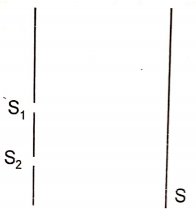In Young's double-slit experiment the intensity of light on screen due to each slit is Interference pattern is observed along a direction parallel to the line , on-screen S

The minimum, maximum, and the intensity averaged over the entire screen are respectively:
1. 0, 4, 2
2. 0, 4,
3. , 2, 3/2
4. 0, ,


To unlock all the explanations of 14 chapters you need to be enrolled in MasterClass Course.

To unlock all the explanations of 14 chapters you need to be enrolled in MasterClass Course.
An unpolarized beam of light of intensity passes through two linear polarizers making an
angle of 30 with respect to each other. The emergent beam will have an intensity:
1.
2.
3.
4.

To unlock all the explanations of 14 chapters you need to be enrolled in MasterClass Course.

To unlock all the explanations of 14 chapters you need to be enrolled in MasterClass Course.
A beam of monoenergetic electrons, which have been accelerated from rest by a potential U, is used to form an interference pattern in Young's double-slit experiment. The electrons are now accelerated by potential 4U. The fringe width:
1. Remains the same
2. Is half the original fringe width
3. Is twice the original fringe width
4. Is one-fourth the original fringe width

To unlock all the explanations of 14 chapters you need to be enrolled in MasterClass Course.

To unlock all the explanations of 14 chapters you need to be enrolled in MasterClass Course.
A source of light passes through three planes polarizes. The first two polarizers are in the same direction, while the third is rotated with respect to the second polarizer. What is the frequency of the light that comes out of the third polarizer?
1.
2.
3.
4. Light will not pass through the third polarizer

To unlock all the explanations of 14 chapters you need to be enrolled in MasterClass Course.

To unlock all the explanations of 14 chapters you need to be enrolled in MasterClass Course.
In young's experiment, the wavelength of red light is cm and that of blue light cm. The value of n for which (n+1)th blue bright band coincides with the nth red band is:
1. 4
2. 3
3. 2
4. 1

To unlock all the explanations of 14 chapters you need to be enrolled in MasterClass Course.

To unlock all the explanations of 14 chapters you need to be enrolled in MasterClass Course.
Light of wavelength 6000 is incident on a single slit. The first minimum of the diffraction pattern is obtained at 4 mm from the center. The screen is at a distance of 2 m from the slit. The slit width will be:
1. 0.3 mm
2. 0.2 mm
3. 0.15 mm
4. 0.1 mm

To unlock all the explanations of 14 chapters you need to be enrolled in MasterClass Course.

To unlock all the explanations of 14 chapters you need to be enrolled in MasterClass Course.
In Young's double-slit experiment, the distance between the two sources is 0.1 mm. The distance of the screen from the sources is 20 cm. The wavelength of light used is 5460 . Then the angular position of first dark fringe is:
1. 0.08
2. 0.16
3. 0.20
4. 0.32

To unlock all the explanations of 14 chapters you need to be enrolled in MasterClass Course.

To unlock all the explanations of 14 chapters you need to be enrolled in MasterClass Course.
The main difference between the phenomena of interference and diffraction is that:
| 1. | diffraction is caused by reflected waves from a source whereas interference is caused due to the refraction of waves from a source. |
| 2. | diffraction is caused due to the interaction of waves derived from the same source, whereas interference is the bending of light from the same wavefront. |
| 3. | diffraction is caused due to the interaction of light from the same wavefront, whereas the interference is the interaction of two waves derived from the same source. |
| 4. | diffraction is caused due to the interaction of light from the same wavefront whereas interference is the interaction of waves from two isolated sources. |

To unlock all the explanations of 14 chapters you need to be enrolled in MasterClass Course.

To unlock all the explanations of 14 chapters you need to be enrolled in MasterClass Course.
In Young's double-slit experiment, the phase difference between light waves reaching 3rd bright fringe from the central fringe when , is:
1.
2.
3.
4. zero

To unlock all the explanations of 14 chapters you need to be enrolled in MasterClass Course.

To unlock all the explanations of 14 chapters you need to be enrolled in MasterClass Course.
In an interference pattern produced by two identical slits, the intensity at the position of the central maximum is \(I.\) The intensity at the same spot when either of the slits is closed is \(I_0.\) Therefore,
1. \(I=I_0\)
2. \(I=2I_0\)
3. \(I=4I_0\)
4. \(I\) and \(I_0\) are not related to each other

To unlock all the explanations of 14 chapters you need to be enrolled in MasterClass Course.

To unlock all the explanations of 14 chapters you need to be enrolled in MasterClass Course.






